





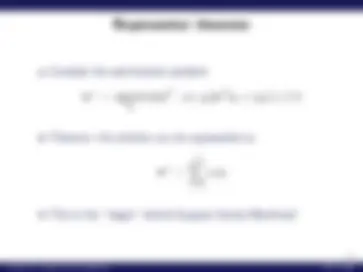






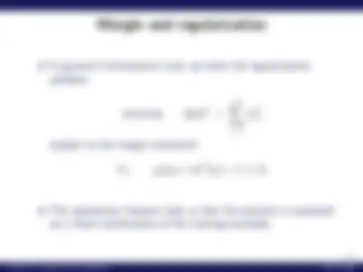


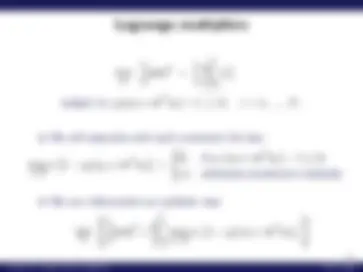


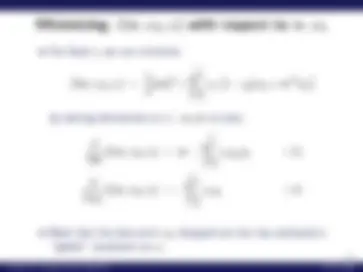

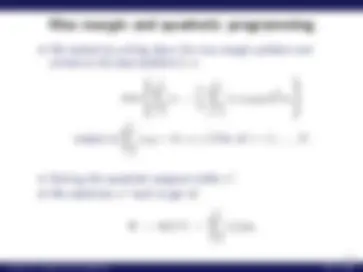
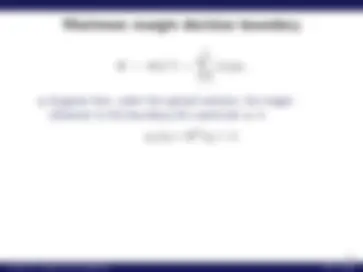
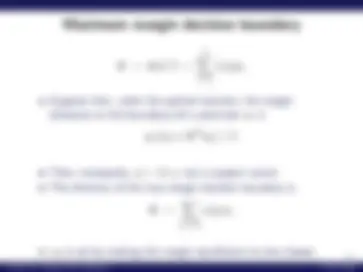
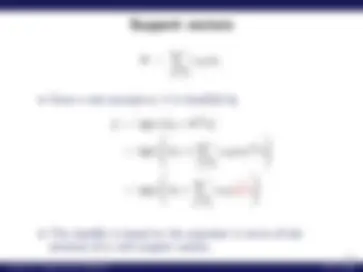

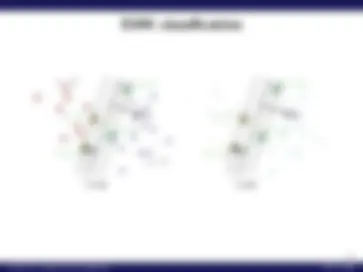
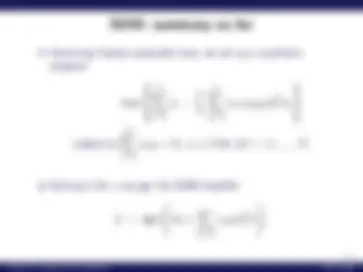
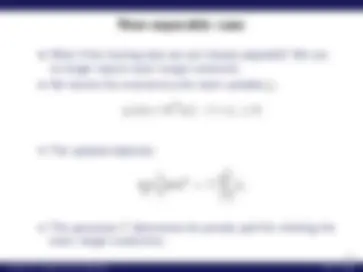



Study with the several resources on Docsity

Earn points by helping other students or get them with a premium plan


Prepare for your exams
Study with the several resources on Docsity

Earn points to download
Earn points by helping other students or get them with a premium plan
Community
Ask the community for help and clear up your study doubts
Discover the best universities in your country according to Docsity users
Free resources
Download our free guides on studying techniques, anxiety management strategies, and thesis advice from Docsity tutors
Support Vector Machines, Andreas Argyriou, Large Margin Classification, Optimal Separating Hyperplane, Optimal Linear Classifier, Representer Theorem, Regularization, Lagrange Multipliers, Max-Margin Optimization, Quadratic Programming, Margin Decision Boundary, Support Vectors, SVM Classification, Nonlinear Decision Boundaries, Greg Shakhnarovich, Lecture Slides, Introduction to Machine Learning, Computer Science, Toyota Technological Institute at Chicago, United States of America.
Typology: Lecture notes
1 / 37

This page cannot be seen from the preview
Don't miss anything!






























TTIC 31020: Introduction to Machine Learning
Instructor: Greg Shakhnarovich
Lecture by Andreas Argyriou
TTI–Chicago
October 20, 2010
Large margin classification; optimal separating hyperplane
Support Vector Machines
Which decision boundary is better?
Which decision boundary is better?
Regularization alone does not capture this intuition
Distance from a correctly classified (x, y) to the boundary:
‖w‖
y
wT^ x + w 0
Margin of the classifier on X = {(xi, yi)}Ni=1, assuming it
achieves 100% accuracy: the distance to the closest point
min i
‖w‖
yi
w
T xi + w 0
We are interested in a large margin classifier:
argmax w,w 0
‖w‖
min i
yi
w
T xi + w 0
So, we seek argmaxw,w 0
1 ‖w‖ mini^ yi
wT^ xi + w 0
Hard optimization problem... but: we can set
min i
yi
w
T xi + w 0
since can rescale ‖w‖, w 0 appropriately.
Then, the optimization becomes:
argmax w,w 0
‖w‖
s.t. yi
wT^ xi + w 0
≥ 1 , ∀i = 1,... , N.
Consider the optimization problem
w
∗ = argmin w
‖w‖
2 s.t. yi(w
T xi + w 0 ) ≥ 1 ∀i
Theorem: the solution can be represented as
w∗^ =
i=
αixi
This is the “magic” behind Support Vector Machines!
w∗^ = argmin w
‖w‖^2 s.t. yi(wT^ xi + w 0 ) ≥ 1 ∀i ⇒ w∗^ =
∑^ N
i=
αixi
Let w∗^ = wX + w⊥, where wX =
i=1 αixi^ ∈^ Span(x^1 ,... ,^ xN^ ), w⊥ ∈/ Span(x 1 ,... , xN )
w∗^ = argmin w
‖w‖^2 s.t. yi(wT^ xi + w 0 ) ≥ 1 ∀i ⇒ w∗^ =
∑^ N
i=
αixi
Let w∗^ = wX + w⊥, where wX =
i=1 αixi^ ∈^ Span(x^1 ,... ,^ xN^ ), w⊥ ∈/ Span(x 1 ,... , xN ), i.e., wT ⊥xi = 0 for all i = 1,... , N
For all xi we have
w
∗T xi = w
T X xi^ +^ w
T ⊥xi^ =
w∗^ = argmin w
‖w‖^2 s.t. yi(wT^ xi + w 0 ) ≥ 1 ∀i ⇒ w∗^ =
∑^ N
i=
αixi
Let w∗^ = wX + w⊥, where wX =
i=1 αixi^ ∈^ Span(x^1 ,... ,^ xN^ ), w⊥ ∈/ Span(x 1 ,... , xN ), i.e., wT ⊥xi = 0 for all i = 1,... , N
For all xi we have
w
∗T xi = w
T X xi^ +^ w
T ⊥xi^ =^ w
T X xi
w∗^ = argmin w
‖w‖^2 s.t. yi(wT^ xi + w 0 ) ≥ 1 ∀i ⇒ w∗^ =
∑^ N
i=
αixi
Now, we have
‖w∗‖^2 = w∗
T w∗
w∗^ = argmin w
‖w‖^2 s.t. yi(wT^ xi + w 0 ) ≥ 1 ∀i ⇒ w∗^ =
∑^ N
i=
αixi
Now, we have
‖w∗‖^2 = w∗
T w∗^ = (wX + w⊥)
T (wX + w⊥)
w∗^ = argmin w
‖w‖^2 s.t. yi(wT^ xi + w 0 ) ≥ 1 ∀i ⇒ w∗^ =
∑^ N
i=
αixi
Now, we have
‖w∗‖^2 = w∗
T w∗^ = (wX + w⊥)
T (wX + w⊥) = wX T^ wX ︸ ︷︷ ︸ ‖wX ‖^2
since wTX w⊥ = 0.
Suppose w⊥ 6 = 0. Then, we have a solution wX that satisfies
all the constraints, and for which ‖wX ‖^2 < ‖wX ‖^2 + ‖w⊥‖^2 = ‖w∗‖^2.
w∗^ = argmin w
‖w‖^2 s.t. yi(wT^ xi + w 0 ) ≥ 1 ∀i ⇒ w∗^ =
∑^ N
i=
αixi
Now, we have
‖w∗‖^2 = w∗
T w∗^ = (wX + w⊥)
T (wX + w⊥) = wX T^ wX ︸ ︷︷ ︸ ‖wX ‖^2
since wTX w⊥ = 0.
Suppose w⊥ 6 = 0. Then, we have a solution wX that satisfies
all the constraints, and for which ‖wX ‖^2 < ‖wX ‖^2 + ‖w⊥‖^2 = ‖w∗‖^2.
This contradicts optimality of w∗, hence w∗^ = wX. QED